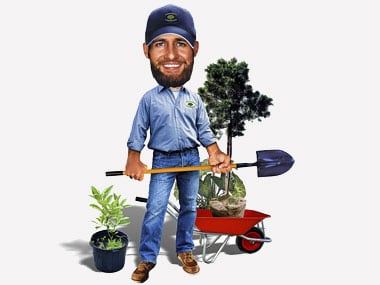Win against weeds
Wipe them out now and future control will be easy
A few weeds may not seem like an urgent problem, but you can’t leave them alone. While you’re ignoring them, they’re spreading. Wait too long, and your eradication job will soon double, then double again. If, on the other hand, you attack when their numbers are small, you can wipe them out in just a few minutes and future weed control will require only occasional spot treatments.
Identify, then attack
There are three types of weeds. Each type requires different products and application methods. So before you can defeat them, you have to know which type you’re up against.
Broadleaf weeds
Unlike grasses, broadleaf weeds have (surprise!) broad leaves. Some common examples are dandelions, clover and creeping Charlie (ground ivy).
Annual grasses
Grasses like crabgrass reseed themselves near the end of the growing season and then die. The seeds germinate the following spring to grow new plants.
Perennial grasses
Grassy weeds like quack grass go dormant through the winter, along with your grass, only to reemerge in the spring. They spread through the roots and seeds.
The very best weed control
A healthy lawn is an inhospitable place for weeds. Thick, lush grass chokes out existing weeds and prevents new weeds from taking hold.
Kill annual grasses (and fertilize at the same time!)
The most cost-effective way to control crabgrass is to use a fertilizer with crabgrass preventer added to it. But you have to do this in the spring, before crabgrass seeds germinate. Apply it when you would normally apply your first application of fertilizer, and do it just before it rains to work both the fertilizer and the herbicide into the soil. The fertilizer will help thicken the turf. Thicker turf helps to squeeze out crabgrass plants missed by the herbicide.
Kill perennial grasses one by one
Perennial grassy weeds have sprawling underground root systems. Pulling the grass only gets some of the roots, and the remaining ones will quickly sprout new plants. The only effective solution is to use a “nonselective” plant killer like Roundup. Nonselective products kill all plants, so you have to apply them to the weed and only to the weed. Here’s one way: Slip on a rubber chemically resistant glove (they’re labeled as such) to protect your skin. Then put on a cheap cloth glove. Dip your fingers in herbicide and wipe the weed. Toss the glove in the trash when you’re done.
Don’t fight weeds where grass won’t grow
If you’ve tried more than once to nurture grass in an area and failed, it might be time to throw in the towel and treat the area with a landscaping alternative. The obvious choices are stone, mulch and attractive ground cover plants that tolerate the same conditions grass can’t handle.
Kill broadleaf weeds
Herbicides formulated for broadleaf control will kill broadleafs only—they won’t kill grasses. The key is to use only as much as needed. That saves time and money and keeps you from needlessly introducing chemicals into the environment.
Spot-kill weeds with a small pressure sprayer
For a few isolated weeds, spot-treat the weeds with a small, trigger-controlled, pump-up pressure sprayer filled with a mix of herbicide concentrate and water. You can also buy broadleaf killer premixed in spray bottles.
Treat weed patches with a 1- or 2-gallon sprayer
Patches or clumps of weeds are best treated with a tank sprayer filled with a mix of herbicide concentrate and water. This is faster and more economical than buying several spray bottles of premixed herbicide. After spraying, triple-rinse the sprayer to flush out all the herbicide.
Treat large areas with a dial sprayer
If your whole lawn is filled with weeds, use a dial sprayer attached to your garden hose. Add concentrated broadleaf killer to the pot and set the dial at the top to the mixture called for on the herbicide container. Hook up the garden hose and apply an even treatment to the weedy areas. Clear the yard of anything that can get contaminated by overspray. And protect your flowers and bushes with plastic sheeting or cardboard. Broadleaf killers will kill or harm anything with leaves—including your flower bed.
